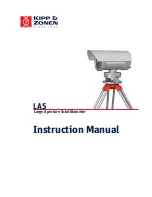
6
β
Bowen ratio [-] (
β
=
H
/
L
v
E
)
λ
wavelength of EM radiation (880 nm) [m]
ρ
density of air [kg m
-3
] [
∼
1.2 kg m
-3
(at sea level (1013 hPa)!)]
2
σ
variance
2
ln
I
σ
of natural logarithm of intensity fluctuations ( ln(
I
) ) [-]
2
2
I
U
DEMOD
σ
σ
=
of
U
DEMOD
or intensity
I
[V
2
]
2
2
CN
U
σ
of
U
CN2
[V
2
]
ABBREVIATIONS
BET
Basic
Evapo-Transpiration
system
(X)LAS
(eXtra) Large Aperture Scintillometer
MOST
Monin-Obukhov Similarity Theory
A relationship describing the vertical behavior of non-dimensionalized mean
flow and turbulence properties within the Surface Layer as a function of the
Monin–Obukhov key parameters.
PBL
Planetary Boundary Layer
The PBL is the lowest region of the troposphere, which is directly affected by
heating and cooling of the earth surface. In general the depth of the PBL
varies between 100m to 2000m. The depth of the PBL increases during the
day, when the surface is heated by the sun and decreases during the night
due to radiative cooling.
RET
Radio
Evapo-Transpiration
system
RS
Roughness
Sublayer
Lowest part of the SL, where the flow is influenced by individual roughness
elements. Consequently, the SL can be divided into the Constant Flux Layer
and the Roughness Sublayer. The height of the Roughness Sublayer strongly
depends on the height (size and form) of the roughness elements, but also on
the distribution. Usually, over tall vegetation 3 times the obstacle height is
taken as the height of the Roughness Sublayer.
SL
Surface
Layer
In general in the lowest 10% of the PBL the surface fluxes are constant with
height, this part of the PBL is also known as the Constant Flux Layer or
Surface Layer (SL). Therefore fluxes measured in the SL can be considered
as being representative fluxes for
the
heat and mass exchange processes
between the atmosphere and the surface. In general the SL varies between
20m to 100m and like the PBL increases during the day and decreases again
during the night.
Summary of Contents for LAS
Page 1: ...Instruction Manual Large Aperture Scintillometer LAS...
Page 28: ...27 Figure 17 Operational weather station of LAS RET system...
Page 29: ...28...
Page 39: ...38...
Page 45: ...44...
Page 49: ...48...
Page 51: ...50 Figure 33 Configuration screen and default settings of supplied RF modems...
Page 55: ...54...
Page 69: ...68...
Page 71: ...70 APPENDIX 9 CONNECTION PLAN LAS BET LAS RET Figure 47 Connection plan LAS BET system...
Page 72: ...71...
Page 73: ...72 Figure 48 Connection plan weather station LAS RET system...
Page 74: ...73 Figure 49 Connection plan scintillometer LAS RET system...






















